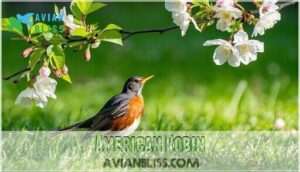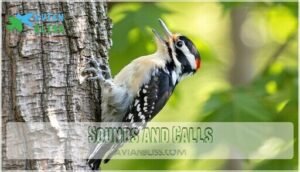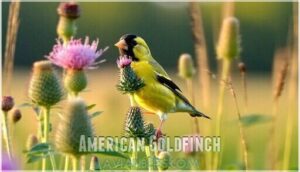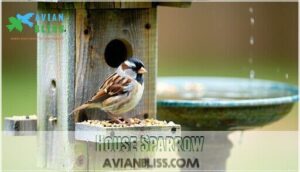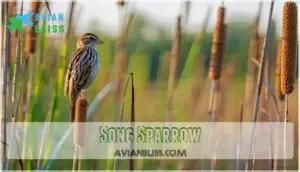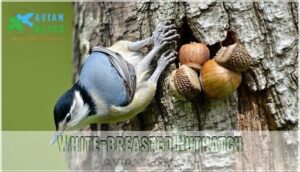This site is supported by our readers. We may earn a commission, at no cost to you, if you purchase through links.
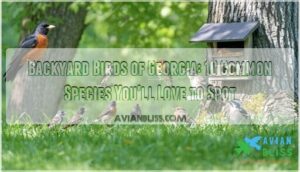
American Robins hop across lawns with their red breasts, while Downy and Hairy Woodpeckers tap oak trees in rhythmic patterns.
American Goldfinches flash bright yellow during spring, contrasting with the brown House Sparrows and red-headed House Finches at your feeders.
American Crows call from treetops as Song Sparrows chirp melodic notes from bushes.
White-breasted Nuthatches spiral headfirst down bark, and Red-winged Blackbirds flash scarlet shoulder patches near water.
Each species has specific feeding preferences and nesting habits that’ll help you attract them consistently.
Table Of Contents
- Key Takeaways
- American Robin
- Downy Woodpecker
- Hairy Woodpecker
- American Goldfinch
- House Sparrow
- House Finch
- American Crow
- Song Sparrow
- White-breasted Nuthatch
- Red-winged Blackbird
- Frequently Asked Questions (FAQs)
- How do I identify a bird in my backyard?
- What’s the most common bird in Georgia?
- Is it good to have birds in your yard?
- What is Georgia’s national bird?
- What is the best bird seed for Georgia birds?
- What is Georgias official state bird?
- Which feeders attract the most bird species?
- When do most Georgia birds breed?
- What foods should I offer backyard birds?
- How can I identify Brown Thrasher calls?
- Conclusion
Key Takeaways
- You’ll easily identify Georgia’s most common backyard birds by watching for distinctive features like the American Robin’s orange-red breast, male cardinals’ bright red plumage, and the Downy Woodpecker’s black and white striped pattern with red head patches on males.
- You can attract the widest variety of species by offering black oil sunflower seeds in platform feeders, which work for 92.5% of bird species, plus suet for woodpeckers and nyjer seeds for goldfinches.
- You’ll notice seasonal changes throughout the year as American Goldfinches molt from brilliant yellow summer plumage to drab brown winter colors, while some robins migrate south during colder months.
- You’ll create a thriving backyard ecosystem that increases biodiversity by up to 40% when you provide fresh water, native plants, and consistent food sources for these ten common Georgia birds.
American Robin
You’ll easily recognize the American Robin by its bright orange-red breast and dark gray head, making it one of Georgia’s most familiar backyard visitors.
These medium-sized birds hop across your lawn searching for earthworms and insects, especially after spring rains when the ground is soft.
Range and Characteristics
You’ll find American Robins throughout Georgia’s diverse habitats year-round, from bustling suburbs to quiet woodlands.
These beloved Georgia birds showcase distinct physical traits that make bird identification simple.
- Rusty-red breast that catches morning sunlight
- Dark gray head contrasting with bright yellow beak
- White eye-ring creating an alert expression
- Sturdy 8-10 inch frame built for ground foraging
- Confident posture while hunting earthworms
Their behavior patterns include lawn-hopping and fruit-gathering adventures across backyard bird territories.
You can find products related to robin’s habitat range online, which is useful for understanding their habitat range and ground foraging habits, making them a great example of beloved Georgia birds.
Songs and Calls
You’ll recognize American Robins by their distinctive songs long before spotting their red breasts. These Georgia birds produce complex melodies with remarkable song complexity, stringing together cheerful phrases that sound like "cheerily, cheer-up, cheer-up."
Listen for their sharp "tut-tut-tut" calls when alarmed or their softer "peek" notes during flight. Male robins use territorial defense songs to claim prime nesting spots, repeating their musical phrases from prominent perches.
You’ll notice call variations throughout the day – aggressive chattering near threats versus gentle contact calls between mates. While robins don’t exhibit true vocal mimicry like mockingbirds, their bird sounds remain among the most recognizable and beloved in any Georgia backyard.
Downy Woodpecker
You’ll recognize the Downy Woodpecker as Georgia’s smallest woodpecker, measuring just 6-7 inches with a black and white striped pattern and the male’s distinctive red patch on the back of his head.
These year-round residents frequent backyard feeders for suet and can be heard making their sharp "pik" calls while tapping on tree bark in search of insects.
Identifying Features
The Downy Woodpecker’s compact size makes it Georgia’s smallest woodpecker, measuring just 6-7 inches.
You’ll spot distinctive plumage coloration featuring bold black and white stripes across the back and wings.
Males display a bright red patch on their nape, while females lack this marking.
The bill shape appears short and chisel-like, perfect for excavating insects from bark.
Notice the black cap contrasting sharply with white cheeks and underparts.
Tail length stays relatively short with black feathers showing white outer edges.
Eye color appears dark against the white facial pattern.
This backyard bird’s favorite visits feeders regularly throughout Georgia.
You can find a specialized Downy feeder to attract them.
When identifying birds, focus on these key markings rather than size alone, as the similar Hairy Woodpecker shares comparable features but appears markedly larger with different proportions.
Sounds and Calls
The Downy Woodpecker’s bird vocalizations create a symphony you’ll recognize instantly.
These small birds produce distinct bird calls that serve important functions in bird communication and territorial defense. Listen for their signature sounds during the dawn chorus when bird songs fill Georgia mornings.
- Sharp "peek" notes in rapid succession
- High-pitched whinnying call that carries far
- Soft rattling sounds resembling gentle whimpers
- Rhythmic drumming at eight beats per second
Their call variations help distinguish them from similar species at your bird feeder, which is an important aspect of bird communication and territorial defense.
Hairy Woodpecker
Looking beyond Georgia’s smallest woodpecker, you’ll encounter its robust cousin making deeper, more resonant sounds in your backyard.
The Hairy Woodpecker stands nearly twice the size of the Downy, measuring 7-10 inches with a bill as long as its head. This black-and-white striped bird prefers mature forests but readily visits suburban yards with large trees.
Hairy Habitat includes woodlots, parks, and forest edges throughout Georgia. Their Hairy Diet consists mainly of wood-boring insects, though they’ll visit suet feeders. To attract these birds, consider providing a specialized feeder.
Hairy Nesting occurs in dead tree cavities 6-12 inches deep. Hairy Sounds include sharp "peek" calls and whinnying notes, plus energetic drumming on tree trunks.
Hairy Lookalikes create confusion with Downy Woodpeckers, but size and bill length separate these backyard birds. Males sport red head patches while females display solid black crowns, making woodpecker identification straightforward once you know the differences.
American Goldfinch
You’ll recognize American Goldfinch males by their brilliant yellow summer plumage and jet-black wings. These charming backyard birds undergo dramatic molting plumage changes throughout the year.
In winter, both sexes turn drab brown and buff, making identification trickier. Unlike most Georgia birds, goldfinches delay nesting behavior until late July through September when thistle seeds ripen.
Their goldfinch diet consists primarily of seeds from weedy plants and birdseed from your feeders. Attracting goldfinches requires nyjer and sunflower seeds in tube or sock feeders.
These social birds don’t follow typical goldfinch migration patterns, instead moving locally based on food availability.
- Watch males transform from dull winter gray to stunning summer gold
- Listen for their distinctive bouncy flight call and cheerful warbling songs
- Enjoy their acrobatic feeding antics at your bird feeders
House Sparrow
Despite their small size, House Sparrows pack a big punch in Georgia’s backyard bird scene.
These invasive species arrived from Europe in the 1850s and never looked back.
You’ll spot males by their black bibs and gray caps, while females wear brown streaks throughout.
Their House Sparrow diet includes seeds, grains, and scraps from your patio table.
These common birds build messy nests in building crevices, mailboxes, and traffic lights.
Sparrow identification becomes easier when you notice their chunky build and constant chatter.
While controlling sparrows proves challenging, focus on attracting native Georgia birds instead.
House sparrows are known for opportunistic feeding strategies, including scavenging and adapting to seasonal changes.
Georgia boasts approximately 431 bird species in total, making it a diverse bird watching location.
Plant native seeds and provide clean water to encourage biodiversity in your backyard birds community, promoting a healthy environment for native Georgia birds and supporting their backyard bird scene with clean water and native seeds.
House Finch
House finches bring vibrant splashes of color to Georgia backyards year-round.
These adaptable birds thrive in urban settings, making finch identification relatively easy for backyard birds enthusiasts.
Males display rosy-pink throats and rumps, while females show brownish plumage with subtle red hints.
You’ll spot them in flocks at bird feeders, especially those offering black oil sunflower seeds.
Their feeding habits focus primarily on seeds, which they crush with rapid bites.
House finches also enjoy fruits and weeds.
For attracting finches, maintain consistent food sources and consider their nesting behavior – they prefer urban areas near human activity.
- Males get their red coloring from pigments in their food
- Flocks can contain several hundred birds
- They’re highly social except during breeding season
- Originally from western states, now found throughout Georgia
- Females prefer brightly colored males for mating
American Crow
Georgia’s most recognizable corvid, the American Crow, brings remarkable intelligence to your backyard.
These large, all-black birds with glossy feathers measure up to 21 inches and weigh over a pound.
Crow Intelligence shines through their tool use and problem-solving abilities that rival young children.
Their Corvid Communication includes complex vocalizations beyond simple caws – they produce rattles, clicks, and even mimic other sounds.
| Crow Behavior | What You’ll See |
|---|---|
| Feeding | Ground foraging in groups |
| Social | Flocks of hundreds gathering |
| Territory | Chasing away hawks and owls |
| Problem-solving | Opening containers for food |
| Communication | Various calls and responses |
These common birds adapt easily to Crow Habitat ranging from forests to urban areas.
Their Crow Diet includes everything from insects to garbage, making them excellent backyard visitors when you offer peanuts or corn.
Song Sparrow
Flitting through dense vegetation with characteristic tail-pumping flight, the Song Sparrow ranks among Georgia’s most melodious backyard birds.
You’ll recognize this medium-sized sparrow by its streaky brown plumage, thick white chest streaks, and rounded tail.
Here’s what makes Song Sparrow identification easy:
- Stuttering, clattering song from exposed perches
- Short, fluttering flights with downward tail pumps
- Streaky brown back with bold white chest markings
- Preference for marsh edges and overgrown fields
- Year-round presence throughout Georgia
Song Sparrow sounds include varied trills that brighten spring mornings.
Their sparrow habitat encompasses woodlands, suburban areas, and wetland edges.
During sparrow nesting season, they build cup-shaped nests in low vegetation.
Song Sparrow diet shifts from insects in summer to seeds in winter.
White-breasted Nuthatch
While most birds hop along branches, the White-breasted Nuthatch defies gravity by walking headfirst down tree trunks.
This stocky backyard bird sports blue-gray upperparts with a crisp white face and underparts.
Males wear distinctive black caps, while females sport gray ones.
Their climbing behavior sets them apart from other Georgia birds.
You’ll spot them probing bark crevices with their long, narrow bills, searching for insects and larvae.
Their nuthatch diet shifts seasonally—insects during summer, seeds and nuts in winter.
They’re famous for wedging acorns into bark and hammering them open.
Listen for their distinctive vocalizations: a nasal "yank-yank" call that echoes through woodlands.
Their habitat preferences include mature forests, parks, and suburban areas with large trees.
| Physical Features | Behavior | Habitat |
|---|---|---|
| Blue-gray upperparts | Headfirst climbing | Mature forests |
| White face/underparts | Bark probing | Suburban parks |
| Black cap (males) | Nut wedging | Wooded areas |
| Gray cap (females) | Upside-down foraging | Dead tree cavities |
| Stocky build | Year-round presence | Backyard feeders |
These nesting habits involve using tree cavities, making them excellent candidates for your bird identification adventures.
Red-winged Blackbird
You’ll spot male Red-winged Blackbirds flashing their bright red shoulder patches while defending territories in Georgia’s marshes and wetlands.
Their distinctive "conk-la-ree!" call echoes across cattail marshes where they build nests.
During winter, massive flocks gather at feeders and roost sites, and Red-wing habitat includes ditches, swamps, and even backyard water features.
These common birds migrate through the state during fall and spring, with males arriving first to claim prime real estate, making blackbird identification easier for Georgia birdwatchers.
Frequently Asked Questions (FAQs)
How do I identify a bird in my backyard?
Over 92% of bird species use platform feeders, making identification easier.
Look for size, color patterns, beak shape, and behavior.
Note the bird’s location, feeding style, and distinctive markings to narrow down your identification quickly.
What’s the most common bird in Georgia?
The Northern Cardinal tops the list, visiting 6% of Georgia feeders.
You’ll recognize males by their bright red plumage and distinctive crest.
These year-round residents prefer sunflower seeds at hopper or tray feeders.
Is it good to have birds in your yard?
Like having nature’s own pest control service, you’ll love watching birds eat insects that damage your plants.
They pollinate flowers, spread seeds, and provide endless entertainment while creating a healthier yard ecosystem, which can be considered as having your own natural entertainment.
What is Georgia’s national bird?
Georgia’s state bird is the Brown Thrasher, not a national bird.
This fox-colored songster with bright yellow eyes became official in
You’ll recognize its long tail and complex songs mimicking other birds.
What is the best bird seed for Georgia birds?
Black oil sunflower seeds work best for most Georgia birds.
You’ll attract cardinals, finches, and chickadees easily.
Platform feeders or hoppers distribute seeds effectively.
Adding suet attracts wrens and woodpeckers for complete backyard diversity.
What is Georgias official state bird?
You’ll absolutely love discovering that the magnificent Brown Thrasher proudly holds the title as Georgia’s official state bird! This fox-colored beauty was declared in 1935 and officially voted in
Which feeders attract the most bird species?
Platform feeders attract the most bird species at 5% effectiveness.
You’ll see cardinals, finches, and sparrows flocking to these open-style feeders.
They’re perfect starter feeders since birds feel comfortable accessing food from all angles.
When do most Georgia birds breed?
Like nature’s spring awakening, Georgia’s feathered residents begin their romantic symphony in March.
You’ll witness most breeding activity from March through August, with peak nesting occurring during April and May when conditions are ideal.
What foods should I offer backyard birds?
You’ll attract the most Georgia birds with black oil sunflower seeds, suet, and whole peanuts.
Platform feeders work best initially, then add hopper feeders.
Consistency matters more than variety for successful backyard bird feeding.
How can I identify Brown Thrasher calls?
You’ll recognize Brown Thrashers by their sharp "check" or "chuck" calls and complex, whistled songs that mimic other birds.
They’re loudest during breeding season at dawn and dusk, singing varied musical phrases.
Conclusion
Attracting these backyard birds of Georgia to your yard increases biodiversity by up to 40% compared to unmanaged spaces.
You’ll create a thriving ecosystem by providing fresh water, native plants, and appropriate feeders for each species.
Watch for seasonal changes as American Goldfinches molt from bright yellow to olive-brown in winter, while American Robins may migrate south.
Start with basic birdseed and suet feeders, then expand your setup as you identify which backyard birds of Georgia visit most frequently, creating a more biodiverse environment with native plants.

